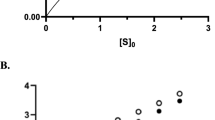Play all audios:

IN considering the energetics of an enzyme-catalysed reaction it is of interest to enquire into what constitutes the “drive”, in a thermodynamic sense, for the reaction, particularly when
the enzyme is involved in an energy-coupled process. This often arises when speculations are made on the operation of a system on the basis of equilibrium constants for the reaction scheme
determined on the system, or fragments of it, in vitro. In the case of active transport or muscular contraction the free energy for transport or contraction is derived from the hydrolysis of
ATP and the overall drive arises because the chemical potential of ATP is greater than that of its products (ADP and Pi) at physiological concentrations. But to understand how the drive is
expressed in the mechanism of such processes it is necessary to consider and define the relative free energy levels of the intermediates of the reaction. The free energy and standard free
energy as normally defined as not sufficient for this purpose. They both, in general, refer to the system as a whole and are used in the context of free energy changes involving substrates,
products and ligands. The drive of the system, in the sense used here, is to be sought in the relative disposition of the free energy levels of an individual (time-averaged) macromolecule
and in the manner in which these levels favour (stochastically) a particular direction of the flux in what may be a complicated reaction scheme. We refer to these free energy levels of
individual macromolecules as the “basic” free energy levels. To avoid confusion we have termed the overall free energy change of the whole system for a given transition as the “gross” free
energy change. The definitions of and relationships between the standard, basic, and gross free energy levels for a system of macromolecules (either in free solution or immobilised) are
given below, together with a simple example relevant to muscular contraction. A more mathematically detailed version of this work with more complicated examples for both muscle and active
transport has been published elsewhere1,2.
Anyone you share the following link with will be able to read this content:
